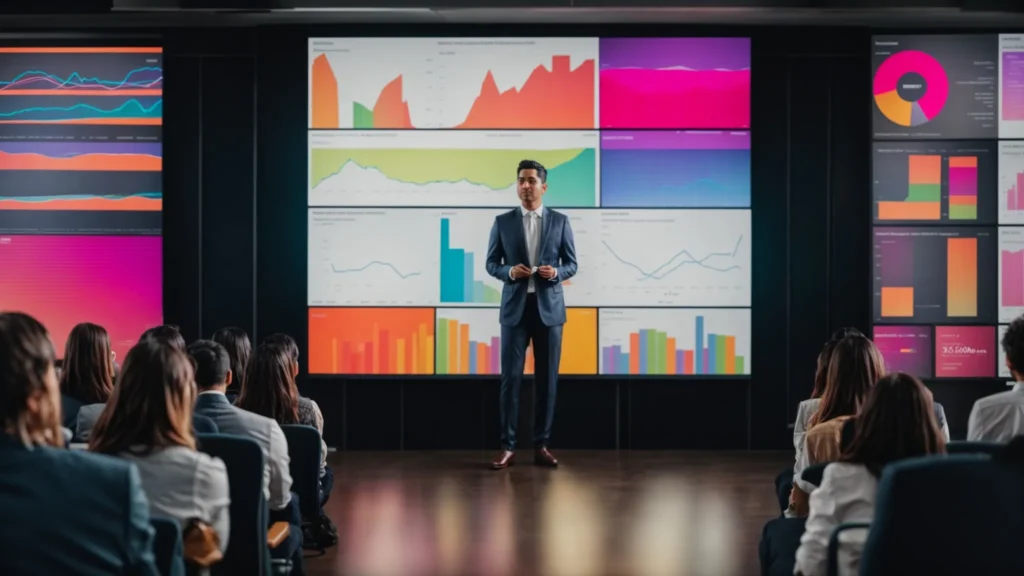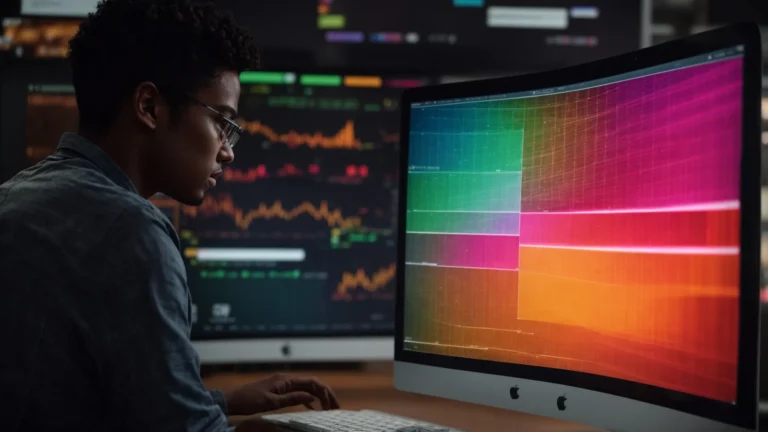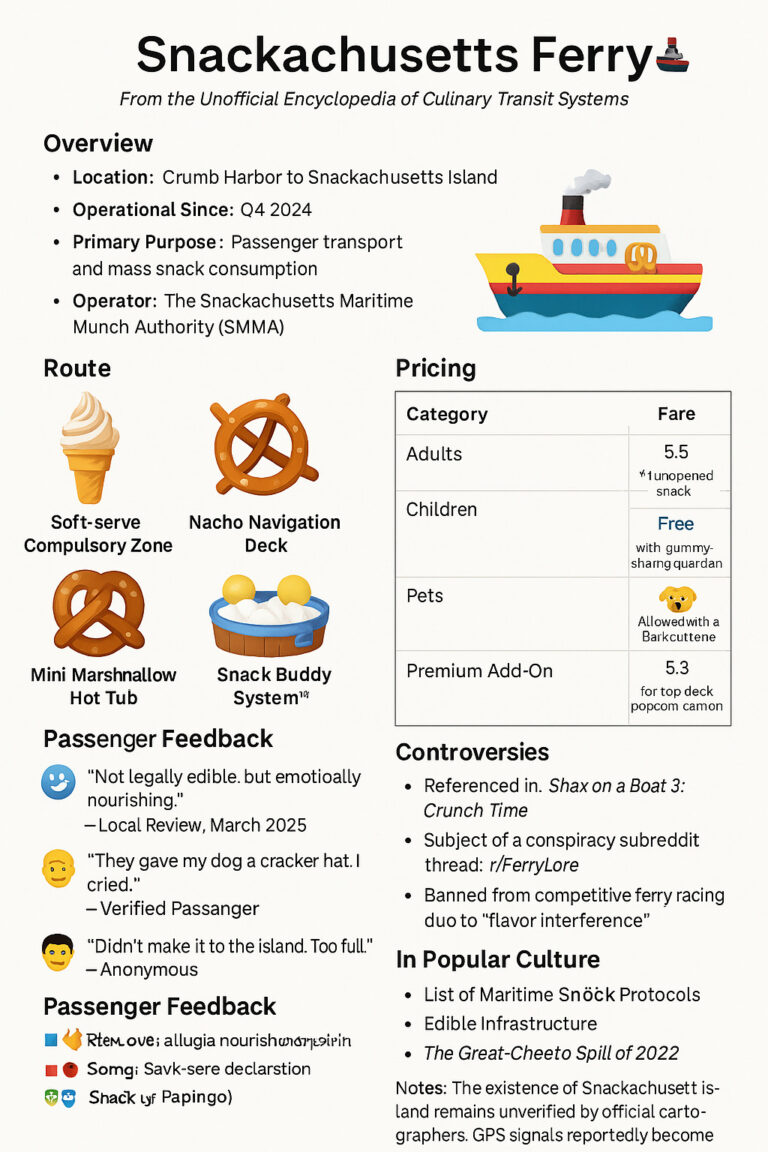Maximize Your Impact: LinkedIn Video Optimization Strategies
In the dynamic world of professional networking, LinkedIn has evolved into a hub for incisive content, particularly through video.
As a social media video creator, navigating this space requires an astute understanding of user experience to enhance brand awareness and foster meaningful conversations.
By tapping into the art of video optimization, your content not only achieves greater visibility but also resonates more deeply with your target audience, driving lead generation and amplifying your message.
Enhancing your LinkedIn videos for maximum impact demands strategic finesse and attention to detail, from video production nuances to algorithm-friendly practices.
Keep reading to discover how to finetune your video content, ensuring it stands out in a sea of digital narratives.
Key Takeaways
- Optimal LinkedIn Video Lengths Are Between 30 Seconds to 2 Minutes for High Engagement
- Aspect Ratio Selection Greatly Affects Visibility and User Engagement on LinkedIn
- Accurate Metadata and Keyword Research Enhance LinkedIn Video Discoverability
- Captions and Sound Quality Are Essential for Maximizing Mobile User Engagement
- An Effective Call to Action Is Crucial for Transitioning Viewers to Business Outcomes
The Right Format and Aspect Ratio for LinkedIn Videos

In the realm of LinkedIn, a social media video creator must navigate through a labyrinth of technical nuances to ensure their message is received with clarity and impact.
Embarking on the creation process entails a pivotal decision between landscape, portrait, and square videos, each bearing its own potential to enhance user experience and bolster brand awareness.
Grasping LinkedIn’s stringent technical requirements is essential, as these specifications act as the gatekeepers to content deliverability and ultimately, viewer reception.
Additionally, the selected aspect ratio stands as a silent influencer of visibility and engagement, where an inappropriate choice could diminish the conversation in your professional community or impede the brand ambassador’s quest for lead generation.
This understanding serves not just as a guideline but as a strategic foundation for any marketer or company aiming to carve out their narrative in this bustling digital business hub.
Choosing Between Landscape, Portrait, and Square Videos
In the bustling realm of LinkedIn, the decision to use landscape, portrait, or square video formats is more than a question of aesthetics; it’s a strategic move that influences how content is consumed and shared. Landscape videos, synonymous with traditional media, cater to those seeking an expansive view, while portrait videos align seamlessly with mobile app interfaces, fostering an immersive user experience that encourages prolonged engagement. Square videos, on the other hand, strike a versatile balance, offering high visibility across multiple platforms without the need for device rotation, making them an invaluable asset for social media marketing initiatives geared towards maximizing brand exposure.
Understanding LinkedIn’s Technical Requirements
To successfully integrate video content into a LinkedIn strategy, one must adhere to the platform’s exacting technical stipulations: Video files that exceed specified sizes or diverge from approved formats are subject to rejection, hindering visibility and thwarting efforts in conversation and community building. It is critical for businesses and social media managers to absorb this information, transforming it into a seamless extension of their content marketing playbook.
- Analyze LinkedIn’s prescribed video lengths and file sizes to prevent upload issues.
- Ensure videos maintain the recommended aspect ratio for optimal user experience and display.
- Employ accurate metadata, including descriptions and tags, to improve discoverability within the platform’s search results.
How Aspect Ratio Affects Visibility and Engagement
The aspect ratio of a LinkedIn video wields significant influence over its engagement levels and visibility. A strategic alignment with the platform’s preferred dimensions ensures that the video fills the screen appropriately, capturing the audience’s attention and reinforcing the brand’s message. Furthermore, by catering to both desktop and mobile app viewers, a meticulously chosen aspect underpins the user experience, making it conducive for heightened interaction and fostering deeper customer relationships.
Now that you’ve nailed the optimal format for impact on LinkedIn, let’s unlock the secrets of video duration. Prepare to master the art of timing, keeping viewers hooked from beginning to end.
Mastering the Perfect Length and Duration

As digital marketers and social media video creators refine their LinkedIn strategies, grappling with video length and duration emerges as critical to captivate the target audience effectively.
While brevity may allure the ever-busy professionals, comprehensive narratives require longer videos to convey intricate messages.
Here lies the complex balance between crafting concise content that resonates quickly and providing in-depth pieces for thorough understanding.
This delicate equilibrium impacts not just initial viewer engagement, but also how long a user stays tuned in, making it imperative for brands to closely analyze the impact of video duration on viewer retention and craft their content accordingly.
Optimal Video Length for LinkedIn Engagement
The constraints of time and the value of information hold sway in the decision-making process regarding the optimal video length for LinkedIn engagement. Statistical data reveals a sweet spot for video duration that balances comprehensive storytelling with the succinctness valued by busy professionals: typically, videos spanning 30 seconds to 2 minutes garner the highest levels of interactivity and response. Consequently, brands striving to amplify their social media impact must tailor their video content’s length to resonate within this temporal framework, ensuring their message captivates the intended audience promptly and effectively.
| Video Duration | Engagement Potential | Suitability |
|---|---|---|
| Under 30 seconds | Low | Quick Tips, Brief Announcements |
| 30 seconds to 2 minutes | High | Product Demos, Testimonials, Company Updates |
| Over 2 minutes | Medium | Detailed Tutorials, In-depth Interviews |
Short vs. Long Videos: What Works Best?
Strategizing the length of LinkedIn videos hinges on the content’s purpose and the intended audience’s preferences: short videos often thrive due to the platform’s professional tempo, swiftly delivering value and capturing immediate attention, whereas longer videos cater to an immersive narrative, affording the space to delve deeper into topics for viewers willing to invest the time. Choosing between brevity and depth requires a nuanced understanding of audience behavior, with an eye towards maximizing engagement and cultivating meaningful conversation within the digital business landscape.
The Impact of Video Duration on Viewer Retention
The interplay between video duration and viewer retention on LinkedIn cannot be overstated; a judiciously timed video not only garners initial views but also has the potential to keep the audience engaged throughout its entirety. By striking the right balance, one can prevent the precipitous drop-off in attention that often plagues longer videos, ensuring that the core message is not only seen but also absorbed, thereby paving the way for stronger brand connections and customer engagement.
Harnessing the art of time is just the beginning; the true magic lies in the message itself. Let’s shift our focus and delve into the heart of compelling content that echoes with your audience.
Crafting Content and Messages That Resonate

For social media strategists and content creators, LinkedIn is not just a platform but an influential stage to showcase their brand’s narrative and engage with a professional audience.
Targeted messaging begins with a clear understanding of that audience’s composition, interests, and online behavior.
Developing a content structure that captivates the audience from the initial frame and maintains that eagerness throughout is critical.
Clarity in one’s message ensures that communication is not just broadcasted but received and acknowledged, planting the seeds for vigorous viewer engagement.
These elements underscore the crux of a robust LinkedIn video optimization strategy, aimed at constructing resonant content that aligns with company goals and sparks meaningful dialogues within its targeted community.
Identifying Your Audience on LinkedIn
Discerning the specific demographics and interests of your LinkedIn audience forms the cornerstone of effective video content strategy. By meticulously analyzing user engagement patterns and professional attributes, companies can tailor their message to resonate authentically with the right subset of LinkedIn’s diverse user base, thus intensifying the relevance and impact of their social media marketing efforts.
Structuring Your Content for Maximum Impact
For the savvy social media video creator, the architecture of LinkedIn content demands a strategic approach to maximize impact: it’s not merely about what you say, but how you say it. Each frame, each transition, and every second count towards constructing a compelling narrative that captures attention and delivers value. The structure of your content is a language in itself, fortifying the message with an invisible but palpable strength that can propel brand awareness to new heights.
- Commence with a gripping headline to seize immediate attention.
- Introduce the problem or need that your brand or solution addresses.
- Highlight key benefits and features through animation or testimonials.
- Implement a consistent and vibrant visual design to maintain viewer interest.
- Conclude with an unambiguous call to action that prompts viewer response.
Message Clarity and Its Role in Viewer Engagement
In the tapestry of LinkedIn’s professional networking space, message clarity emerges as the linchpin of viewer engagement: a crystal-clear message slices through the digital noise, resonating with precision and fostering genuine connections with the platform’s myriad of users. Precision in language and intent, paired with a judicious selection of narrative-driven visuals, amplifies the impact of the message, enhancing the user experience and carving a lasting impression in the minds of viewers. Muddled communications, by contrast, can cause disinterest and swift disengagement, diminishing the potential for meaningful conversation and desired actions, such as lead generation or sales conversions.
- Employ straightforward language that articulates the core message with simplicity and directness.
- Use compelling visuals that reinforce the spoken or written message for enhanced comprehension.
- Create an immersive narrative that guides viewers seamlessly from introduction to call-to-action.
Transitioning from well-crafted content to a more immersive experience is our next voyage. Let’s amplify our reach by infusing our media with sound and captions to ensure no one misses a beat.
Enhancing Accessibility With Sound and Captions

Ensuring your LinkedIn video content reaches the widest possible audience necessitates a meticulous approach to the inclusion of sound and captions.
Strategically incorporating background music and sound effects enriches the storytelling element of your video, captivating the viewer’s senses and bolstering the emotional appeal of your message.
Adding captions, on the other hand, isn’t merely a nod to inclusivity; it’s an imperative strategy that broadens your reach to individuals who watch without sound, especially the mobile users who comprise a substantial segment of LinkedIn’s audience.
Understanding these auditory components and their interplay with accessibility can thus significantly enhance the effectiveness of your video content, driving engagement and reinforcing your brand’s presence on this professional platform.
When to Use Background Music and Sound Effects
The judicious incorporation of background music and sound effects in LinkedIn videos serves to set an emotional tone and underscore key moments within the narrative. Deploying these auditory elements at pivotal points can transform the tempo of the content, guiding the viewer’s emotional journey and anchoring their attention to the unfolding story. Carefully selected audio cues can signal transitions, emphasize important concepts, and create a memorable atmosphere that supports the brand’s message.
| Video Segment | Background Music | Sound Effects | Purpose |
|---|---|---|---|
| Introduction | Soft, welcoming tune | None | To greet and ease viewers into the video |
| Main Content | Inspirational melody | Subtle highlights for key points | To maintain engagement and emphasize the message |
| Call to Action | Climactic, actionable music | Sound that signifies a revelation or conclusion | To motivate viewers to take the desired action |
How to Add Captions to Your LinkedIn Videos
To ensure maximum accessibility and enhance the viewer experience on LinkedIn, adding captions to your videos is a strategic necessity. Captions can be incorporated directly through LinkedIn’s native video uploader, where you can either upload a pre-existing subtitle file or manually transcribe the dialogue. Embracing this layer of textual information not only adheres to inclusivity standards but also caters to the preferences of users who engage with content in sound-sensitive environments.
| Step | Action | Outcome |
|---|---|---|
| 1 | Choose LinkedIn’s video uploader | Initiate the video captioning process |
| 2 | Upload a pre-made subtitle file or transcribe | Integrate accurate captions into the video |
| 3 | Review and edit for synchronization | Ensure captions match the audio precisely |
The Importance of Sound for Mobile Viewers
Recognizing the burgeoning prevalence of mobile usage, the crafting of LinkedIn videos with mobile viewers in mind is no longer optional but imperative. The presence of skillfully integrated sound enhances the viewing experience, offering a multi-sensory immersion that amplifies engagement even on smaller screens. Consequently, the meticulous cultivation of soundscapes in video content can be a decisive factor that elevates a brand’s reach and impact among the growing contingent of LinkedIn users who primarily engage via mobile devices.
| Component | Mobile Viewers | Impact on Engagement |
|---|---|---|
| Sound Quality | Crucial for retention | Facilitates emotional connection |
| Volume Balance | Key for clarity | Ensures message is heard |
| Audio Clarity | Important for comprehension | Enhances understanding of content |
Ensuring inclusivity in our content marries beautifully with the next crucial steps. Let’s dive into refining our videos to reach their peak potential through optimization and testing strategies.
Video Optimization and Testing Strategies

In the landscape of professional networking, leveraging LinkedIn’s platform to its fullest potential demands more than just content creation; it necessitates a rigorous approach to optimization and testing.
Engaging in targeted keyword research for video titles and descriptions forms the bedrock of discoverability, ensuring that videos emerge prominently in search engine results.
Meanwhile, A/B testing serves as a fine-tuning instrument, allowing creators to calibrate thumbnails and video intros for maximum effect.
Beyond these front-end efforts, a data-driven mindset is essential to dissect and understand video performance, providing invaluable insights to refine and guide future content strategies.
Optimizing LinkedIn videos is not merely about achieving a transient spike in views but about instituting a cycle of continual improvement and impact.
Keyword Research for LinkedIn Video Titles and Descriptions
Conducting thorough keyword research for LinkedIn video titles and descriptions is a critical step in optimizing content for search engine visibility. By identifying the terms and phrases most relevant to their target audience, businesses can craft metadata that not only resonates with viewers but also aligns with search engine algorithms, thereby enhancing their videos’ reach and relevance in search results. This targeted approach aids in connecting content with the right viewers, effectively bridging the gap between brand messaging and audience interest on LinkedIn.
A/B Testing for Thumbnails and Video Intros
Embarking on A/B testing for thumbnails and video intros allows the astute marketer to gauge visceral reactions, capturing audience interest at first glance. This experimental approach pinpoints which visual and auditory cues trigger engagement, enabling content creators to distill the essence of what drives viewer curiosity. Embracing this empirical method, businesses can fine-tune the gateway to their videos, ensuring the first few moments align with user expectations and precipitate sustained viewing.
Analyzing Video Performance to Guide Future Content
Analyzing video performance is an indispensable element for honing a brand’s LinkedIn strategy: this process not only sheds light on the content’s current impact but also uncovers a wealth of data ripe for crafting future initiatives. By delving into metrics such as view counts, watch time, interaction rates, and audience demographics, companies can distill actionable insights, refining their approach to maximize resonance with their target audience. With these data points as a compass, marketers can tweak elements of their videos—from narrative styles to visual cues—to bolster viewer engagement and drive business objectives forward:
| Metric | Insight | Impact on Content Strategy |
|---|---|---|
| View Count | Popularity and initial interest | Guides title and thumbnail optimization |
| Watch Time | Content retention effectiveness | Informs adjustments in video pacing and length |
| Interaction Rate | Level of audience engagement | Shapes call-to-action refinement and narrative engagement |
| Audience Demographics | Viewer relevance and targeting | Directs demographic targeting and content personalization |
Exciting developments in video optimization pave the way for further success on LinkedIn. Let’s shift our focus to other key factors that can amplify your video content’s impact on this professional platform.
Additional Considerations for LinkedIn Video Success

Delving deeper into the nuances of LinkedIn video optimization, one cannot overstate the importance of integrating compelling calls to action, which serve as the driving force behind viewer response and engagement.
Further amplifying a video’s reach, LinkedIn video ads emerge as a persuasive force in the marketing arsenal, offering targeted exposure and the potential for significant impact.
Meanwhile, staying attuned to LinkedIn’s evolving algorithms ensures that videos remain not just relevant, but favored in a landscape shaped by the perpetual flux of technology and user behavior.
Together, these strategies form a multifaceted approach to mastering a dynamic platform and achieving resounding success in the digital spectrum of professional networking.
Incorporating Calls to Action in Your Videos
Every LinkedIn video should culminate with a persuasive call to action that prompts the viewer to proceed to the next logical step, be it visiting a website, signing up for a newsletter, or connecting with a brand representative. Crafting a clear, actionable directive taps into the transformative power of your content, facilitating the transition from viewer engagement to actual business results. The efficacy of your message is directly proportional to the clarity and relevance of your call to action: it should inspire, motivate, and provide an easy path for the audience to follow.
Offer viewers a simple, intuitive way to respond, such as a clickable link or a straightforward instruction.
- Create a call to action that aligns with the core objective of your video.
- Ensure the call to action is concise, direct, and visually prominent at the end of the video.
Leveraging LinkedIn Video Ads for Broader Reach
Investing in LinkedIn video ads amplifies a brand’s presence by positioning content in front of a finely-tuned audience, harnessing the power of demographic targeting and influencer marketing. By integrating sponsored video content within the LinkedIn feed, companies enhance not only their visibility but also the precision of their outreach efforts, driving engagement and fostering meaningful conversations amidst a community of professionals. This approach turns the challenge of attracting a relevant audience into an opportunity for measured, strategic exposure.
Staying Updated With LinkedIn’s Evolving Algorithms
Staying abreast of LinkedIn’s evolving algorithms is vital for ensuring that video content retains its place at the forefront of user feeds. As the platform updates its algorithms to refine user experience and content relevance, understanding these changes can mean the difference between being a passing note or a central conversation piece among professionals. Marketers who regularly research and apply the latest insights into LinkedIn’s content delivery system transform mere visibility into meaningful engagement.
| Algorithm Factors | Content Impact | Optimization Strategy |
|---|---|---|
| Engagement Signals | Heightened Visibility | Encourage viewer interaction with thought-provoking queries. |
| Relevance Scoring | Targeted Reach | Tailor video content to audience interests and industry trends. |
| Quality Assessment | Improved Ranking | Produce high-quality, original videos that provide tangible value. |
Conclusion
Optimizing LinkedIn videos is critical for ensuring content resonates with target audiences and stands out in a competitive digital environment.
Strategic use of aspect ratios, captions, and calls to action can significantly boost engagement and viewer retention.
Employing keyword research and staying abreast of algorithm changes are essential for enhancing discoverability and sustaining relevance on the platform.
Overall, a thoughtful and data-driven approach to LinkedIn video optimization can transform a brand’s content strategy, yielding increased engagement and measurable business results.





